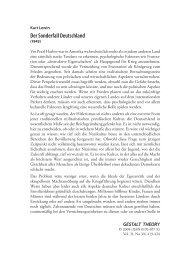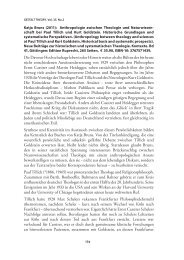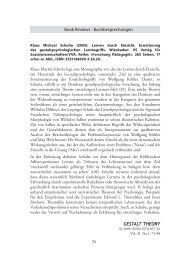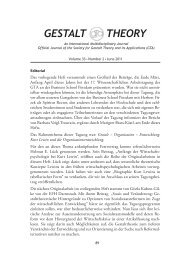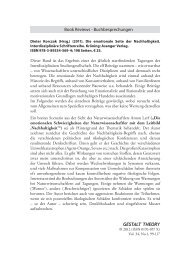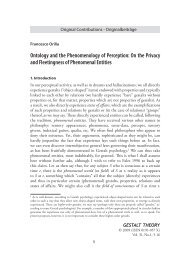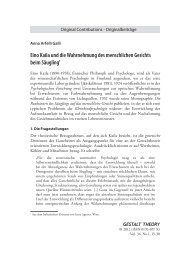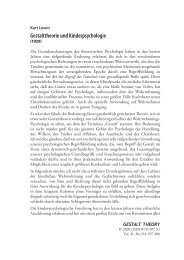What is the Meaning of Shape? - Gestalt Theory
What is the Meaning of Shape? - Gestalt Theory
What is the Meaning of Shape? - Gestalt Theory
You also want an ePaper? Increase the reach of your titles
YUMPU automatically turns print PDFs into web optimized ePapers that Google loves.
385<br />
Pinna, <strong>What</strong> <strong>is</strong> <strong>the</strong> <strong>Meaning</strong> <strong>of</strong> <strong>Shape</strong>?<br />
components necessary to create boundaries. They are not surfaces, but something<br />
similar to perceptual ‘bricks’ necessary to create something more hol<strong>is</strong>tic. In spite<br />
<strong>of</strong> <strong>the</strong> apparent differences between figure-ground segregation and grouping,<br />
what <strong>is</strong> phenomenally clear <strong>is</strong> that both dynamics are so intimately intertwined<br />
that a sharp d<strong>is</strong>tinction <strong>is</strong> likely impossible and maybe useless from a scientific<br />
point <strong>of</strong> view.<br />
Within Rubin’s and Wer<strong>the</strong>imer’s works, <strong>the</strong> problem <strong>of</strong> shape formation <strong>is</strong><br />
approached in terms <strong>of</strong> <strong>the</strong> main conditions operating in two <strong>of</strong> <strong>the</strong> processes<br />
(grouping and figure-ground segregation) underlying but preceding <strong>the</strong> formation<br />
<strong>of</strong> <strong>the</strong> shape. For example, <strong>the</strong> unilateral belongingness <strong>of</strong> <strong>the</strong> boundaries can be<br />
considered as a shape <strong>is</strong>sue before <strong>the</strong> “shape” meaning. It talked about shape<br />
but it did not explain its meaning. Similarly, even if <strong>the</strong> closure principle can<br />
describe <strong>the</strong> perception <strong>of</strong> a square, it cannot say anything about its properties<br />
and about <strong>the</strong> way its properties assign <strong>the</strong> special meanings we have previously<br />
described. Fur<strong>the</strong>rmore, it cannot explain <strong>the</strong> square variations described in <strong>the</strong><br />
next sections.<br />
Even if <strong>Gestalt</strong> grouping and figure-ground principles are part <strong>of</strong> <strong>the</strong> problem <strong>of</strong><br />
shape perception, <strong>the</strong>y do not face directly th<strong>is</strong> problem and, more importantly,<br />
<strong>the</strong>y do not answer basic questions like: what <strong>is</strong> shape? <strong>What</strong> <strong>is</strong> its meaning?<br />
2. General Methods<br />
2.1. Subjects<br />
Different groups <strong>of</strong> 12 undergraduate students <strong>of</strong> architecture, design, lingu<strong>is</strong>tics<br />
participated in <strong>the</strong> experiments. Subjects had some basic knowledge <strong>of</strong> <strong>Gestalt</strong><br />
psychology and v<strong>is</strong>ual illusions, but <strong>the</strong>y were naive both to <strong>the</strong> stimuli and to<br />
<strong>the</strong> purpose <strong>of</strong> <strong>the</strong> experiments. They were male and female with normal or<br />
corrected-to-normal v<strong>is</strong>ion.<br />
2.2. Stimuli<br />
The stimuli were <strong>the</strong> figures shown in <strong>the</strong> next sections. The overall sizes <strong>of</strong> <strong>the</strong><br />
v<strong>is</strong>ual stimuli were ~3.5 deg v<strong>is</strong>ual angle. The figures were shown on a computer<br />
screen with ambient illumination from a Osram Daylight fluorescent light (250<br />
lux, 5600° K). Stimuli were d<strong>is</strong>played on a 33 cm color CRT monitor (Sony<br />
GDM-F520 1600x1200 pixels, refresh rate 100 Hz), driven by a MacBook Pro<br />
computer with an NVIDIA GeForce 8600M GT. Viewing was binocular in <strong>the</strong><br />
frontoparallel plane at a d<strong>is</strong>tance <strong>of</strong> 50 cm from <strong>the</strong> monitor.<br />
2.3. Procedure<br />
Two methods, similar to those used by <strong>Gestalt</strong> psycholog<strong>is</strong>ts, were used.





